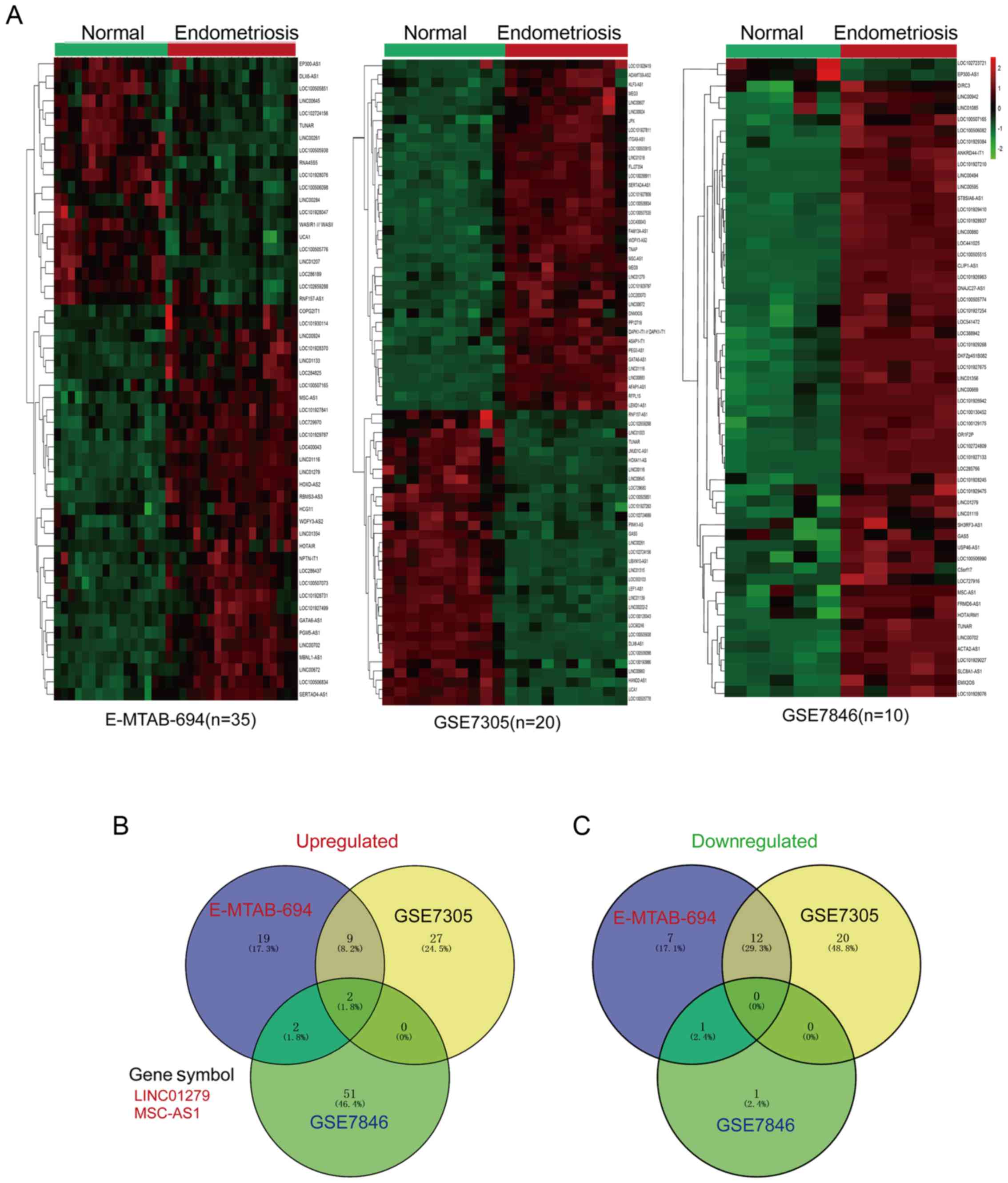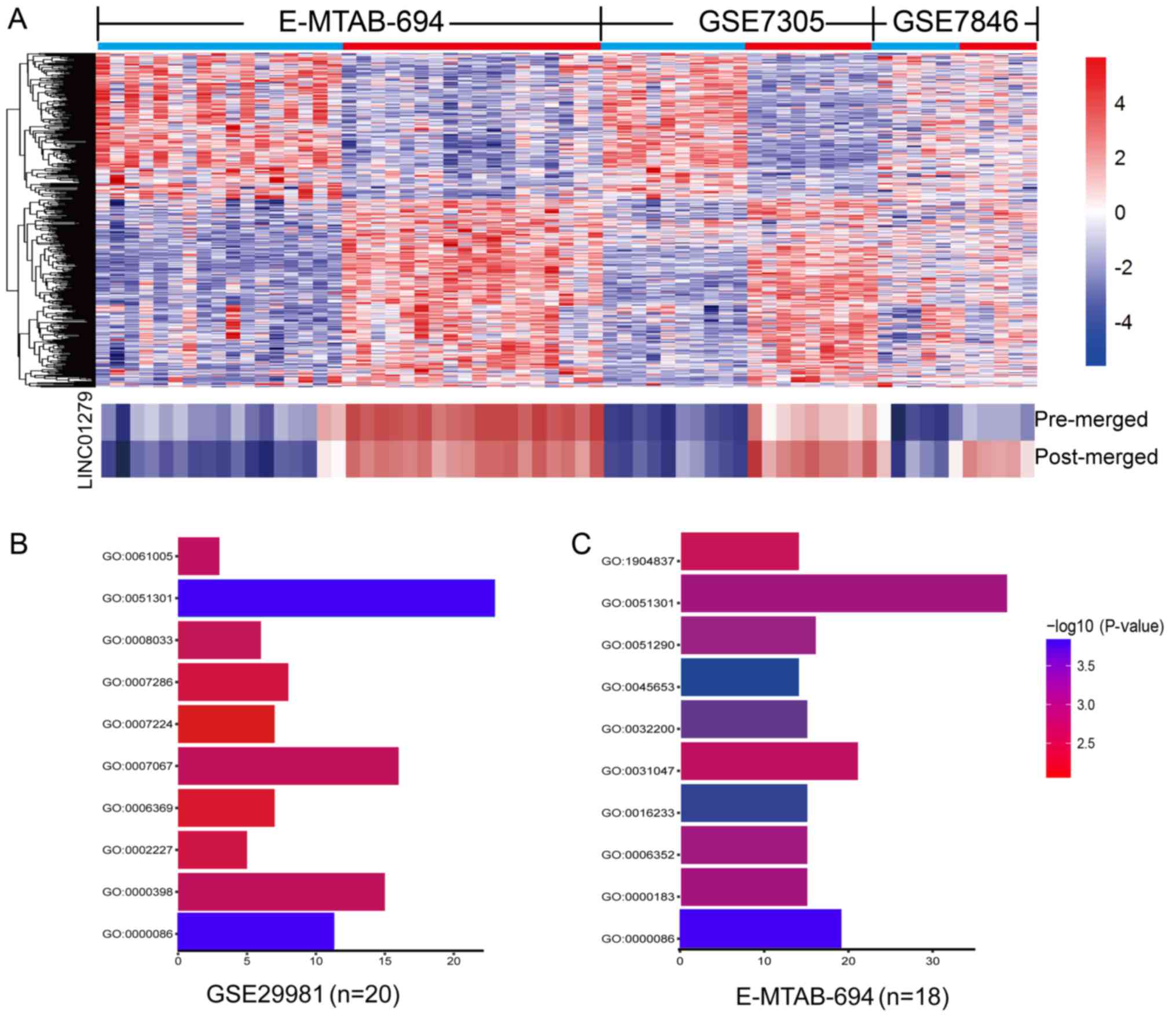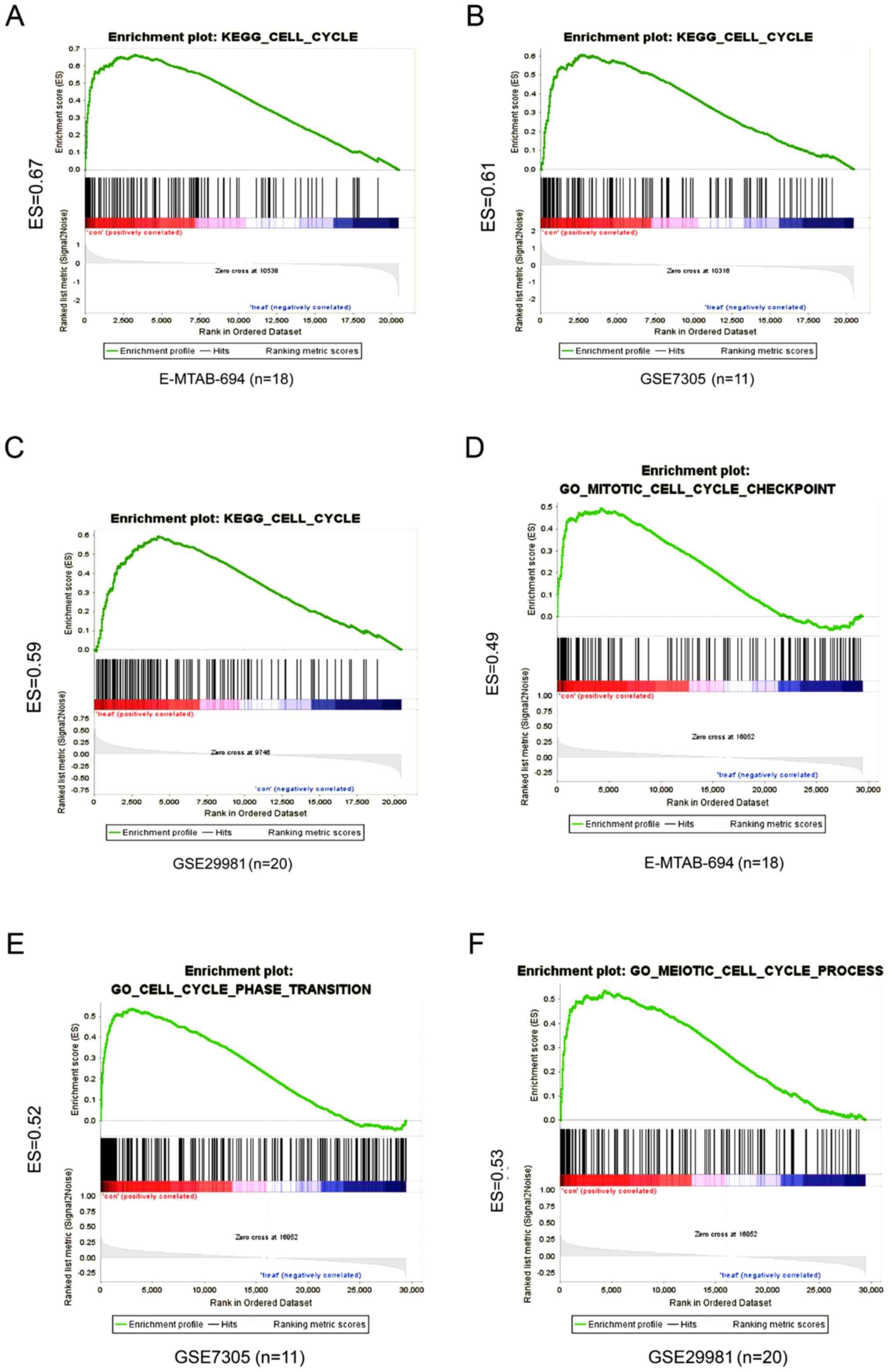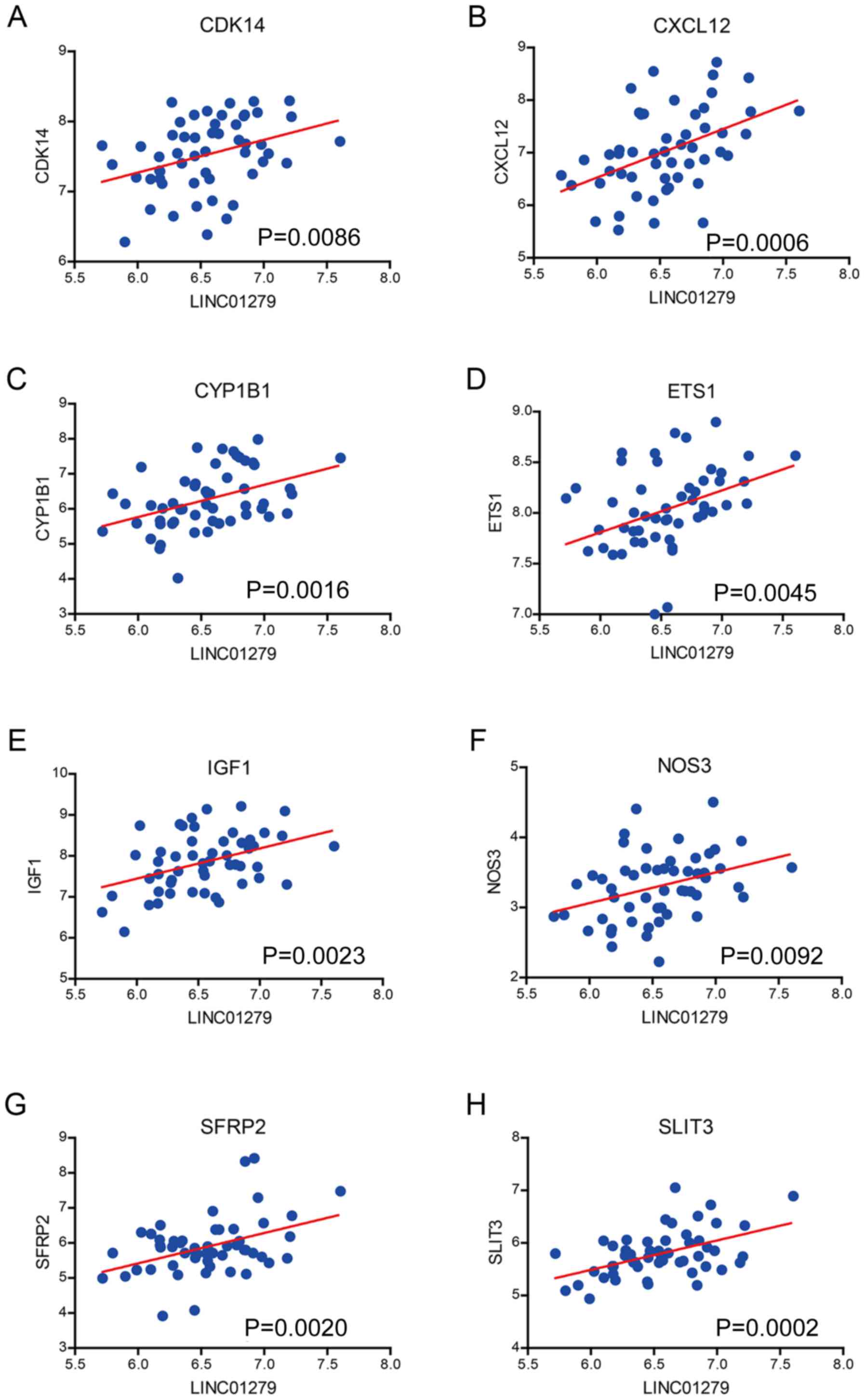|
1
|
Colette S and Donnez J: Endometriosis. N
Engl J Med. 360:1911–1912. 2009. View Article : Google Scholar : PubMed/NCBI
|
|
2
|
Giudice LC: Clinical practice.
Endometriosis. N Engl J Med. 362:2389–2398. 2010. View Article : Google Scholar : PubMed/NCBI
|
|
3
|
Goldman MB and Cramer DW: The epidemiology
of endometriosis. Prog Clin Biol Res. 323:15–31. 1990.PubMed/NCBI
|
|
4
|
Giudice LC and Kao LC: Endometriosis.
Lancet. 364:1789–1799. 2004. View Article : Google Scholar : PubMed/NCBI
|
|
5
|
Moradi M, Parker M, Sneddon A, Lopez V and
Ellwood D: Impact of endometriosis on women's lives: A qualitative
study. BMC Womens Health. 14:1232014. View Article : Google Scholar : PubMed/NCBI
|
|
6
|
Atala A: Re: The long noncoding RNA
SChLAP1 promotes aggressive prostate cancer and antagonizes the
SWI/SNF complex. J Urol. 192:6132014. View Article : Google Scholar : PubMed/NCBI
|
|
7
|
Han P, Li W, Lin CH, Yang J, Shang C,
Nuernberg ST, Jin KK, Xu W, Lin CY, Lin CJ, et al: A long noncoding
RNA protects the heart from pathological hypertrophy. Nature.
514:102–106. 2014. View Article : Google Scholar : PubMed/NCBI
|
|
8
|
Castellanos-Rubio A, Fernandez-Jimenez N,
Kratchmarov R, Luo X, Bhagat G, Green PH, Schneider R, Kiledjian M,
Bilbao JR and Ghosh S: A long noncoding RNA associated with
susceptibility to celiac disease. Science. 352:91–95. 2016.
View Article : Google Scholar : PubMed/NCBI
|
|
9
|
Ghazal S, Mckinnon B, Zhou J, Mueller M,
Men Y, Yang L, Mueller M, Flannery C, Huang Y and Taylor HS: H19
lncRNA alters stromal cell growth via IGF signaling in the
endometrium of women with endometriosis. EMBO Mol Med. 8:996–1003.
2015. View Article : Google Scholar
|
|
10
|
Lee GH, Choi YM, Hong MA, Yoon SH, Kim JJ,
Hwang K and Chae SJ: Association of CDKN2B-AS and WNT4 genetic
polymorphisms in Korean patients with endometriosis. Fertil Steril.
102:1393–1397. 2014. View Article : Google Scholar : PubMed/NCBI
|
|
11
|
Nakaoka H, Gurumurthy A, Hayano T,
Ahmadloo S, Omer WH, Yoshihara K, Yamamoto A, Kurose K, Enomoto T,
Akira S, et al: Allelic imbalance in regulation of ANRIL through
chromatin interaction at 9p21 endometriosis risk locus. PLoS Genet.
12:e10058932016. View Article : Google Scholar : PubMed/NCBI
|
|
12
|
ENCODE Project Consortium, . An integrated
encyclopedia of DNA elements in the human genome. Nature.
489:57–74. 2012. View Article : Google Scholar : PubMed/NCBI
|
|
13
|
Harrow J, Frankish A, Gonzalez JM,
Tapanari E, Diekhans M, Kokocinski F, Aken BL, Barrell D, Zadissa
A, Searle S, et al: GENCODE: The reference human genome annotation
for the ENCODE project. Genome Res. 22:1760–1774. 2012. View Article : Google Scholar : PubMed/NCBI
|
|
14
|
Houshdaran S, Nezhat CR, Vo KC, Zelenko Z,
Irwin JC and Giudice LC: Aberrant endometrial DNA methylome and
associated gene expression in women with endometriosis. Biol
Reprod. 95:932016. View Article : Google Scholar : PubMed/NCBI
|
|
15
|
Wang L, Huang W, Ren C, Zhao M, Jiang X,
Fang X and Xia X: Analysis of serum microRNA profile by solexa
sequencing in women with endometriosis. Reprod Sci. 23:1359–1370.
2016. View Article : Google Scholar : PubMed/NCBI
|
|
16
|
Wang Y, Ma CH and Qiao J: Differential
expression of microRNA in eutopic endometrium tissue during
implantation window for patients with endometriosis related
infertility. Zhonghua Fu Chan Ke Za Zhi. 51:436–441. 2016.(In
Chinese). PubMed/NCBI
|
|
17
|
Zhang X, Sun S, Pu JK, Tsang AC, Lee D,
Man VO, Lui WM, Wong ST and Leung GK: Long non-coding RNA
expression profiles predict clinical phenotypes in glioma.
Neurobiol Dis. 48:1–8. 2012. View Article : Google Scholar : PubMed/NCBI
|
|
18
|
Hever A, Roth RB, Hevezi P, Marin ME,
Acosta JA, Acosta H, Rojas J, Herrera R, Grigoriadis D, White E, et
al: Human endometriosis is associated with plasma cells and
overexpression of B lymphocyte stimulator. Proc Natl Acad Sci USA.
104:pp. 12451–12456. 2007; View Article : Google Scholar : PubMed/NCBI
|
|
19
|
Sha G, Wu D, Zhang L, Chen X, Lei M, Sun
H, Lin S and Lang J: Differentially expressed genes in human
endometrial endothelial cells derived from eutopic endometrium of
patients with endometriosis compared with those from patients
without endometriosis. Hum Reprod. 22:3159–3169. 2007. View Article : Google Scholar : PubMed/NCBI
|
|
20
|
Sohler F, Sommer A, Wachter DL, Agaimy A,
Fischer OM, Renner SP, Burghaus S, Fasching PA, Beckmann MW,
Fuhrmann U, et al: Tissue remodeling and nonendometrium-like
menstrual cycling are hallmarks of peritoneal endometriosis
lesions. Reprod Sci. 20:85–102. 2013. View Article : Google Scholar : PubMed/NCBI
|
|
21
|
Irizarry RA, Bolstad BM, Collin F, Cope
LM, Hobbs B and Speed TP: Summaries of Affymetrix GeneChip probe
level data. Nucleic Acids Res. 31:e152003. View Article : Google Scholar : PubMed/NCBI
|
|
22
|
Taminau J, Meganck S, Lazar C, Steenhoff
D, Coletta A, Molter C, Duque R, de Schaetzen V, Weiss Solís DY,
Bersini H and Nowé A: Unlocking the potential of publicly available
microarray data using inSilicoDb and inSilicoMerging R/Bioconductor
packages. BMC Bioinformatics. 13:3352012. View Article : Google Scholar : PubMed/NCBI
|
|
23
|
Breitling R, Armengaud P, Amtmann A and
Herzyk P: Rank products: A simple, yet powerful, new method to
detect differentially regulated genes in replicated microarray
experiments. FEBS Lett. 573:83–92. 2004. View Article : Google Scholar : PubMed/NCBI
|
|
24
|
Huarte M, Guttman M, Feldser D, Garber M,
Koziol MJ, Kenzelmann-Broz D, Khalil AM, Zuk O, Amit I, Rabani M,
et al: A large intergenic noncoding RNA induced by p53 mediates
global gene repression in the p53 response. Cell. 142:409–419.
2010. View Article : Google Scholar : PubMed/NCBI
|
|
25
|
Wang Y, Li Y, Yang Z, Liu K and Wang D:
Genome-wide microarray analysis of long non-coding RNAs in eutopic
secretory endometrium with endometriosis. Cell Physiol Biochem.
37:2231–2245. 2015. View Article : Google Scholar : PubMed/NCBI
|
|
26
|
Fassbender A, Verbeeck N, Börnigen D,
Kyama CM, Bokor A, Vodolazkaia A, Peeraer K, Tomassetti C, Meuleman
C, Gevaert O, et al: Combined mRNA microarray and proteomic
analysis of eutopic endometrium of women with and without
endometriosis. Hum Reprod. 27:2020–2029. 2012. View Article : Google Scholar : PubMed/NCBI
|
|
27
|
Yang RQ, Teng H, Xu XH, Liu SY, Wang YH,
Guo FJ and Liu XJ: Microarray analysis of microRNA deregulation and
angiogenesis-related proteins in endometriosis. Genet Mol Res.
15:2016.https://doi.org/10.4238/gmr.15027826simple10.4238/gmr.15027826
|
|
28
|
Ping S, Ma C, Liu P, Yang L, Yang X, Wu Q,
Zhao X and Gong B: Molecular mechanisms underlying endometriosis
pathogenesis revealed by bioinformatics analysis of microarray
data. Arch Gynecol Obstet. 293:797–804. 2016. View Article : Google Scholar : PubMed/NCBI
|
|
29
|
Choi YJ and Anders L: Signaling through
cyclin D-dependent kinases. Oncogene. 33:1890–1903. 2014.
View Article : Google Scholar : PubMed/NCBI
|
|
30
|
Leconte M, Chouzenoux S, Nicco C, Chéreau
C, Arkwright S, Santulli P, Weill B, Chapron C, Dousset B and
Batteux F: Role of the CXCL12-CXCR4 axis in the development of deep
rectal endometriosis. J Reprod Immunol. 103:45–52. 2014. View Article : Google Scholar : PubMed/NCBI
|
|
31
|
Piccinato CA, Neme RM, Torres N, Sanches
LR, Cruz Derogis PB, Brudniewski HF, E Silva JC and Ferriani RA:
Increased expression of CYP1A1 and CYP1B1 in ovarian/peritoneal
endometriotic lesions. Reproduction. 151:683–692. 2016. View Article : Google Scholar : PubMed/NCBI
|
|
32
|
Sakaguchi H, Fujimoto J, Aoki I, Toyoki H,
Sato E and Tamaya T: Expression of E26 transformation specific
(ETS-1) related to angiogenesis in ovarian endometriosis. Fertil
Steril. 82:507–510. 2004. View Article : Google Scholar : PubMed/NCBI
|
|
33
|
Mu F, Hankinson SE, Schernhammer E, Pollak
MN and Missmer SA: A prospective study of insulin-like growth
factor 1, its binding protein 3, and risk of endometriosis. Am J
Epidemiol. 182:148–156. 2015. View Article : Google Scholar : PubMed/NCBI
|
|
34
|
Kim H, Ku SY, Kim SH, Lee GH, Choi YM, Kim
JM, Lee TH and Moon SY: Endothelial nitric oxide synthase gene
Glu298Asp polymorphism is associated with advanced stage
endometriosis. Hum Reprod. 24:2656–2659. 2009. View Article : Google Scholar : PubMed/NCBI
|
|
35
|
Heinosalo T, Gabriel M, Kallio L, Adhikari
P, Huhtinen K, Laajala TD, Kaikkonen E, Mehmood A, Suvitie P,
Kujari H, et al: Secreted frizzled-related protein 2 (SFRP2)
expression promotes lesion proliferation via canonical WNT
signaling and indicates lesion borders in extraovarian
endometriosis. Hum Reprod. 33:817–831. 2018. View Article : Google Scholar : PubMed/NCBI
|
|
36
|
Greaves E, Collins F, Esnal-Zufiaurre A,
Giakoumelou S, Horne AW and Saunders PT: Estrogen receptor (ER)
agonists differentially regulate neuroangiogenesis in peritoneal
endometriosis via the repellent factor SLIT3. Endocrinology.
155:4015–4026. 2014. View Article : Google Scholar : PubMed/NCBI
|
|
37
|
Yang Y, Jiang Y, Wan Y, Zhang L, Qiu J,
Zhou S and Cheng W: UCA1 functions as a competing endogenous RNA to
suppress epithelial ovarian cancer metastasis. Tumour Biol.
37:10633–10641. 2016. View Article : Google Scholar : PubMed/NCBI
|
|
38
|
Sun M, Nie F, Wang Y, Zhang Z, Hou J, He
D, Xie M, Xu L, De W, Wang Z and Wang J: LncRNA HOXA11-as promotes
proliferation and invasion of gastric cancer by scaffolding the
chromatin modification factors PRC2, LSD1, and DNMT1. Cancer Res.
76:6299–6310. 2016. View Article : Google Scholar : PubMed/NCBI
|
|
39
|
Yu F, Zheng J, Mao Y, Dong P, Lu Z, Li G,
Guo C, Liu Z6 and Fan X: Long non-coding RNA growth arrest-specific
transcript 5 (GAS5) inhibits liver fibrogenesis through a mechanism
of competing endogenous RNA. J Biol Chem. 290:28286–28298. 2015.
View Article : Google Scholar : PubMed/NCBI
|
|
40
|
Ding J, Xie M, Lian Y, Zhu Y, Peng P, Wang
J, Wang L and Wang K: Long noncoding RNA HOXA-AS2 represses P21 and
KLF2 expression transcription by binding with EZH2, LSD1 in
colorectal cancer. Oncogenesis. 6:e2882017. View Article : Google Scholar : PubMed/NCBI
|
|
41
|
Yao J, Zhou B, Zhang J, Geng P, Liu K, Zhu
Y and Zhu W: A new tumor suppressor LncRNA ADAMTS9-AS2 is regulated
by DNMT1 and inhibits migration of glioma cells. Tumour Biol.
35:7935–7944. 2014. View Article : Google Scholar : PubMed/NCBI
|
|
42
|
Ledermann J, Harter P, Gourley C,
Friedlander M, Vergote I, Rustin G, Scott C, Meier W,
Shapira-Frommer R, Safra T, et al: Olaparib maintenance therapy in
platinum-sensitive relapsed ovarian cancer. N Engl J Med.
366:1382–1392. 2012. View Article : Google Scholar : PubMed/NCBI
|
|
43
|
Kim M, Lee SH, Kim J, Lee SE, Kim YJ and
Min CK: Copy number variations could predict the outcome of
bortezomib plus melphalan and prednisone for initial treatment of
multiple myeloma. Genes Chromosomes Cancer. 54:20–27. 2015.
View Article : Google Scholar : PubMed/NCBI
|


















